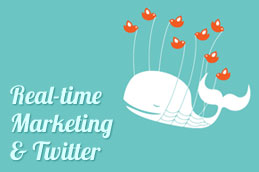Is It Really the Age of Real-Time Marketing?
 Michael Learmonth wrote a great article in Ad Age today about the new and lasting presence of real-time marketing. This recent concept of RTM is used most often to describe marketing on Twitter during big events like the Super Bowl, the State of the Union Address, or in terms of last night and therefore what makes Learmonth’s article so timely, the Academy Awards.
Michael Learmonth wrote a great article in Ad Age today about the new and lasting presence of real-time marketing. This recent concept of RTM is used most often to describe marketing on Twitter during big events like the Super Bowl, the State of the Union Address, or in terms of last night and therefore what makes Learmonth’s article so timely, the Academy Awards.
The article posits that, with companies entering bidding wars to purchase search terms on Twitter such as #blackout during the Super Bowl or #SOTU during the State of the Union, marketing on the fly in real-time is officially a new and important form of brand and sales building.
I’m not so sure. I think another booming technology threatens to cripple any real chance for RTM to hit the mainstream.
Who said Twitter was such a marketing powerhouse?
First, some numbers on Twitter in general. A total of 113.92 million Americans watched the Super Bowl. Only 3 million tweets during that time included the hashtag blackout. That doesn’t mean 3 million people — some of the same tweeters could have used the tag multiple times. And it definitely doesn’t mean millions of people searched Twitter for that hashtag, thereby giving them the opportunity to be presented with ad space purchased by some quick-thinking marketers.
But the effectiveness of Twitter as an ad platform in general isn’t what concerns me about relying on Twitter as the main platform for RTM.
What I think could prevent RTM from truly taking off is the DVR that’s becoming increasingly ubiquitous in American households.
Can DVR and RTM growth go hand-in-hand?
A survey conducted by Leichtman Research Group back in November 2012 found that 52 percent of households with pay TV service also have a digital video recorder that allows them to pause and record live television to watch at a later time.
My household has one. And even though I watched the Academy Awards last night, I didn’t see it live. My 22-month-old baby goes to sleep at 8:30, so I didn’t actually hit play on the broadcast until 42 minutes in. That meant I wasn’t caught up enough to follow along with comments and real-time marketing on Twitter.
The same happened with the State of the Union, where my wife and I continuously paused the speech to discuss it. And during the Super Bowl, where we had to rewind so that a group who arrived late could still see the Jennifer Hudson Sandy Hook performance, and so that a guest who was getting another beer wouldn’t miss the Clydesdale commercial (we’re excellent hosts).
I’m not alone here. A lot of us watch big television events slightly behind. We might not even watch social media heavy shows like American Idol or the Walking Dead on the actual day they air. Consider also that a growing number of “cordcutters” use Hulu, Netflix, and other online services in lieu of having a cable subscription at all.
Is this marketing channel right for you?
What’s my point in all this? Good question. A huge number of companies spent good time and good money last night trying to be part of the live Twitter conversation and trying to buy in real-time terms that they thought would start trending during the Oscars telecast. U.S. Cellular even tweeted a picture of themselves treating their employees terribly: https://twitter.com/edubble_u/status/305845077744443393/photo/1
My challenge to you is to consider how valuable marketing efforts are before you throw money and effort into them. When the potential audience for your campaign includes people in your target demographic who are watching live without any interruptions while heavily engaged on Twitter, how big is your net really? Is it worth taking your employees away from big family events to be stressfully thinking of how to turn an awkward acceptance speech into a brand message?
Just because a marketing medium exists doesn’t mean it’s one worth using. Put your efforts where you know they work.


